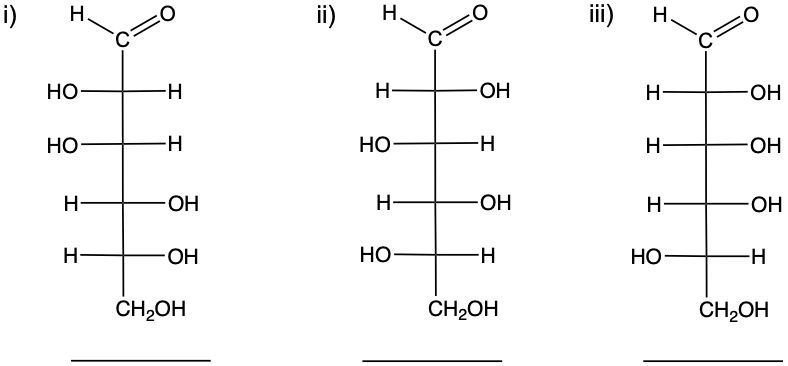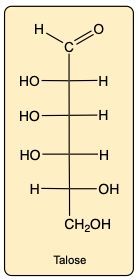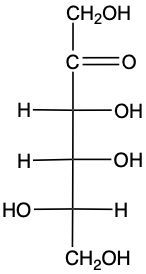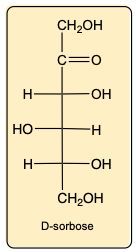When it comes to monosaccharides, we say they can exist as either a D enantiomer or an L enantiomer. D versus L stereochemistry is determined by the penultimate carbon. When we say penultimate here, we're talking about the last chiral carbon. Here we have D ribulose versus L ribulose. So how are we able to determine which one is which? We're going to say for the D enantiomer, the penultimate OH, so again, we're talking about the last chiral carbon, which is this one that's circled. If the OH is on the right side, then it's a D sugar. Enantiomer. Here the penultimate OH, again, we're talking about the last chiral center, the one on the very bottom. If it's on the left side, then it's an L sugar. So left L, sugar, L sugar. So again, we're looking at the last chiral center, looking to see what side the OH is on. Is it on the right side making it a D sugar? Is it on the left side making it an L sugar? And we're going to say what's important here is that when we're talking about carbohydrates, at least from a chemistry aspect, we're going to say most carbohydrates found in nature are going to be D sugars. So D sugar is the predominant sugar form that we're going to look at. Alright. So just keep this in mind, when we're talking about D versus L stereochemistry, it's really looking at the last chiral center and determining what side is the OH on. Is it on the left side or is it on the right side?
- 1. Matter and Measurements4h 29m
- What is Chemistry?5m
- The Scientific Method9m
- Classification of Matter16m
- States of Matter8m
- Physical & Chemical Changes19m
- Chemical Properties8m
- Physical Properties5m
- Intensive vs. Extensive Properties13m
- Temperature (Simplified)9m
- Scientific Notation13m
- SI Units (Simplified)5m
- Metric Prefixes24m
- Significant Figures (Simplified)11m
- Significant Figures: Precision in Measurements7m
- Significant Figures: In Calculations19m
- Conversion Factors (Simplified)15m
- Dimensional Analysis22m
- Density12m
- Specific Gravity9m
- Density of Geometric Objects19m
- Density of Non-Geometric Objects9m
- 2. Atoms and the Periodic Table5h 23m
- The Atom (Simplified)9m
- Subatomic Particles (Simplified)12m
- Isotopes17m
- Ions (Simplified)22m
- Atomic Mass (Simplified)17m
- Atomic Mass (Conceptual)12m
- Periodic Table: Element Symbols6m
- Periodic Table: Classifications11m
- Periodic Table: Group Names8m
- Periodic Table: Representative Elements & Transition Metals7m
- Periodic Table: Elemental Forms (Simplified)6m
- Periodic Table: Phases (Simplified)8m
- Law of Definite Proportions9m
- Atomic Theory9m
- Rutherford Gold Foil Experiment9m
- Wavelength and Frequency (Simplified)5m
- Electromagnetic Spectrum (Simplified)11m
- Bohr Model (Simplified)9m
- Emission Spectrum (Simplified)3m
- Electronic Structure4m
- Electronic Structure: Shells5m
- Electronic Structure: Subshells4m
- Electronic Structure: Orbitals11m
- Electronic Structure: Electron Spin3m
- Electronic Structure: Number of Electrons4m
- The Electron Configuration (Simplified)22m
- Electron Arrangements5m
- The Electron Configuration: Condensed4m
- The Electron Configuration: Exceptions (Simplified)12m
- Ions and the Octet Rule9m
- Ions and the Octet Rule (Simplified)8m
- Valence Electrons of Elements (Simplified)5m
- Lewis Dot Symbols (Simplified)7m
- Periodic Trend: Metallic Character4m
- Periodic Trend: Atomic Radius (Simplified)7m
- 3. Ionic Compounds2h 18m
- Periodic Table: Main Group Element Charges12m
- Periodic Table: Transition Metal Charges6m
- Periodic Trend: Ionic Radius (Simplified)5m
- Periodic Trend: Ranking Ionic Radii8m
- Periodic Trend: Ionization Energy (Simplified)9m
- Periodic Trend: Electron Affinity (Simplified)8m
- Ionic Bonding6m
- Naming Monoatomic Cations6m
- Naming Monoatomic Anions5m
- Polyatomic Ions25m
- Naming Ionic Compounds11m
- Writing Formula Units of Ionic Compounds7m
- Naming Ionic Hydrates6m
- Naming Acids18m
- 4. Molecular Compounds2h 18m
- Covalent Bonds6m
- Naming Binary Molecular Compounds6m
- Molecular Models4m
- Bonding Preferences6m
- Lewis Dot Structures: Neutral Compounds (Simplified)8m
- Multiple Bonds4m
- Multiple Bonds (Simplified)6m
- Lewis Dot Structures: Multiple Bonds10m
- Lewis Dot Structures: Ions (Simplified)8m
- Lewis Dot Structures: Exceptions (Simplified)12m
- Resonance Structures (Simplified)5m
- Valence Shell Electron Pair Repulsion Theory (Simplified)4m
- Electron Geometry (Simplified)8m
- Molecular Geometry (Simplified)11m
- Bond Angles (Simplified)11m
- Dipole Moment (Simplified)15m
- Molecular Polarity (Simplified)7m
- 5. Classification & Balancing of Chemical Reactions3h 17m
- Chemical Reaction: Chemical Change5m
- Law of Conservation of Mass5m
- Balancing Chemical Equations (Simplified)13m
- Solubility Rules16m
- Molecular Equations18m
- Types of Chemical Reactions12m
- Complete Ionic Equations18m
- Calculate Oxidation Numbers15m
- Redox Reactions17m
- Spontaneous Redox Reactions8m
- Balancing Redox Reactions: Acidic Solutions17m
- Balancing Redox Reactions: Basic Solutions17m
- Balancing Redox Reactions (Simplified)13m
- Galvanic Cell (Simplified)16m
- 6. Chemical Reactions & Quantities2h 35m
- 7. Energy, Rate and Equilibrium3h 46m
- Nature of Energy6m
- First Law of Thermodynamics7m
- Endothermic & Exothermic Reactions7m
- Bond Energy14m
- Thermochemical Equations12m
- Heat Capacity19m
- Thermal Equilibrium (Simplified)8m
- Hess's Law23m
- Rate of Reaction11m
- Energy Diagrams12m
- Chemical Equilibrium7m
- The Equilibrium Constant14m
- Le Chatelier's Principle23m
- Solubility Product Constant (Ksp)17m
- Spontaneous Reaction10m
- Entropy (Simplified)9m
- Gibbs Free Energy (Simplified)18m
- 8. Gases, Liquids and Solids3h 25m
- Pressure Units6m
- Kinetic Molecular Theory14m
- The Ideal Gas Law18m
- The Ideal Gas Law Derivations13m
- The Ideal Gas Law Applications6m
- Chemistry Gas Laws16m
- Chemistry Gas Laws: Combined Gas Law12m
- Standard Temperature and Pressure14m
- Dalton's Law: Partial Pressure (Simplified)13m
- Gas Stoichiometry18m
- Intermolecular Forces (Simplified)19m
- Intermolecular Forces and Physical Properties11m
- Atomic, Ionic and Molecular Solids10m
- Heating and Cooling Curves30m
- 9. Solutions4h 10m
- Solutions6m
- Solubility and Intermolecular Forces18m
- Solutions: Mass Percent6m
- Percent Concentrations10m
- Molarity18m
- Osmolarity15m
- Parts per Million (ppm)13m
- Solubility: Temperature Effect8m
- Intro to Henry's Law4m
- Henry's Law Calculations12m
- Dilutions12m
- Solution Stoichiometry14m
- Electrolytes (Simplified)13m
- Equivalents11m
- Molality15m
- The Colligative Properties15m
- Boiling Point Elevation16m
- Freezing Point Depression9m
- Osmosis16m
- Osmotic Pressure9m
- 10. Acids and Bases3h 29m
- Acid-Base Introduction11m
- Arrhenius Acid and Base6m
- Bronsted Lowry Acid and Base18m
- Acid and Base Strength17m
- Ka and Kb12m
- The pH Scale19m
- Auto-Ionization9m
- pH of Strong Acids and Bases9m
- Acid-Base Equivalents14m
- Acid-Base Reactions7m
- Gas Evolution Equations (Simplified)6m
- Ionic Salts (Simplified)23m
- Buffers25m
- Henderson-Hasselbalch Equation16m
- Strong Acid Strong Base Titrations (Simplified)10m
- 11. Nuclear Chemistry56m
- BONUS: Lab Techniques and Procedures1h 38m
- BONUS: Mathematical Operations and Functions47m
- 12. Introduction to Organic Chemistry1h 34m
- 13. Alkenes, Alkynes, and Aromatic Compounds2h 12m
- 14. Compounds with Oxygen or Sulfur1h 6m
- 15. Aldehydes and Ketones1h 1m
- 16. Carboxylic Acids and Their Derivatives1h 11m
- 17. Amines38m
- 18. Amino Acids and Proteins1h 51m
- 19. Enzymes1h 37m
- 20. Carbohydrates1h 46m
- Intro to Carbohydrates4m
- Classification of Carbohydrates4m
- Fischer Projections4m
- Enantiomers vs Diastereomers8m
- D vs L Enantiomers8m
- Cyclic Hemiacetals8m
- Intro to Haworth Projections4m
- Cyclic Structures of Monosaccharides11m
- Mutarotation4m
- Reduction of Monosaccharides10m
- Oxidation of Monosaccharides7m
- Glycosidic Linkage14m
- Disaccharides7m
- Polysaccharides7m
- 21. The Generation of Biochemical Energy2h 8m
- 22. Carbohydrate Metabolism2h 22m
- 23. Lipids2h 26m
- Intro to Lipids6m
- Fatty Acids25m
- Physical Properties of Fatty Acids6m
- Waxes4m
- Triacylglycerols12m
- Triacylglycerol Reactions: Hydrogenation8m
- Triacylglycerol Reactions: Hydrolysis13m
- Triacylglycerol Reactions: Oxidation7m
- Glycerophospholipids15m
- Sphingomyelins13m
- Steroids15m
- Cell Membranes7m
- Membrane Transport10m
- 24. Lipid Metabolism1h 45m
- 25. Protein and Amino Acid Metabolism1h 37m
- 26. Nucleic Acids and Protein Synthesis2h 54m
- Intro to Nucleic Acids4m
- Nitrogenous Bases16m
- Nucleoside and Nucleotide Formation9m
- Naming Nucleosides and Nucleotides13m
- Phosphodiester Bond Formation7m
- Primary Structure of Nucleic Acids11m
- Base Pairing10m
- DNA Double Helix6m
- Intro to DNA Replication20m
- Steps of DNA Replication11m
- Types of RNA10m
- Overview of Protein Synthesis4m
- Transcription: mRNA Synthesis9m
- Processing of pre-mRNA5m
- The Genetic Code6m
- Introduction to Translation7m
- Translation: Protein Synthesis18m
D vs L Enantiomers: Study with Video Lessons, Practice Problems & Examples
 Created using AI
Created using AIMonosaccharides can exist as D or L enantiomers, determined by the position of the hydroxyl (OH) group on the penultimate chiral carbon. If the OH is on the right, it’s a D sugar; if on the left, it’s an L sugar. Most naturally occurring carbohydrates are D sugars. Understanding this stereochemistry is crucial for grasping carbohydrate structure and function, as it influences properties like reactivity and biological roles in processes such as glycolysis and energy metabolism.
D vs L Enantiomers Concept 1
Video transcript
D vs L Enantiomers Example 1
Video transcript
In this example question, it states, "Identify each monosaccharide as D or L enantiomer." So, remember to determine D or L stereochemistry, we look at the penultimate carbon or the last chiral carbon. The last chiral carbon will be this one and this one. If the OH group is on the right side, that makes it a D sugar. So this would be a D enantiomer. And then, if the OH is on the left side (left L), then it's an L enantiomer. So, we would say here that for structure A represents a D enantiomer since the OH is on the right side on the last chiral center, and then we'd say B is an L enantiomer since the OH is on the left side of the last chiral center. Alright. So, that's how we approach this particular example question.
D vs L Enantiomers Example 2
Video transcript
In this example question, it says to draw a C4 epimer of D-fructose. First, we will number this monosaccharide. We start numbering from the end closest to our carbonyl carbon, beginning up here: 1, 2, 3, 4, 5, and 6. The question specifies to design a C4 epimer. An epimer is a type of diastereomer where two structures are similar at all their chiral centers except for one place. Here, that difference is indicated at carbon number 4 (C4). To draw the C4 epimer of fructose, we will ensure that the CH2OH and the carbonyl carbon remain unchanged. We have 1, 2, 3, 4, 5, and 6 in the chain; C3 remains the same. The difference occurs at carbon number 4; we'll flip the orientation so that the OH, which was originally on the right side, is now on the left, and the H is switched accordingly. C5 remains unaffected. This structure now represents the C4 epimer of fructose. We have altered only the chiral center at carbon number 4, which is indicative of a C4 epimer.
Label each as D-enantiomer, L-enantiomer, epimer or neither of Talose.


D-enantiomer, epimer, L-enantiomer
epimer, neither, L-enantiomer
epimer, L-enantiomer, D-enantiomer
neither, epimer, D-enantiomer
Identify the given molecule as diastereomer or epimer of D-sorbose.


Diastereomer
Epimer
Do you want more practice?
Here’s what students ask on this topic:
What is the difference between D and L enantiomers in monosaccharides?
The difference between D and L enantiomers in monosaccharides lies in the position of the hydroxyl (OH) group on the penultimate chiral carbon. For D enantiomers, the OH group is on the right side, while for L enantiomers, it is on the left side. This distinction is crucial because it affects the sugar's properties, including its reactivity and biological roles. Most naturally occurring carbohydrates are D sugars, which play significant roles in processes like glycolysis and energy metabolism.
 Created using AI
Created using AIHow do you determine if a sugar is a D or L enantiomer?
To determine if a sugar is a D or L enantiomer, you need to look at the penultimate chiral carbon, which is the last chiral carbon in the molecule. If the hydroxyl (OH) group on this carbon is on the right side, the sugar is a D enantiomer. If the OH group is on the left side, it is an L enantiomer. This method is used to classify monosaccharides and is essential for understanding their chemical behavior and biological functions.
 Created using AI
Created using AIWhy are most naturally occurring carbohydrates D sugars?
Most naturally occurring carbohydrates are D sugars because of the evolutionary preference in biological systems. Enzymes and other biological molecules have evolved to recognize and interact more efficiently with D sugars. This stereochemical preference ensures that metabolic processes, such as glycolysis and energy production, proceed efficiently. The predominance of D sugars in nature is a result of this evolutionary optimization.
 Created using AI
Created using AIWhat role does the penultimate carbon play in determining D and L enantiomers?
The penultimate carbon, which is the last chiral carbon in a monosaccharide, plays a crucial role in determining whether the sugar is a D or L enantiomer. The position of the hydroxyl (OH) group on this carbon is the key factor: if the OH group is on the right, the sugar is a D enantiomer; if it is on the left, the sugar is an L enantiomer. This classification is important for understanding the sugar's chemical properties and biological functions.
 Created using AI
Created using AIHow does the stereochemistry of D and L sugars affect their biological roles?
The stereochemistry of D and L sugars significantly affects their biological roles because enzymes and other biomolecules are stereospecific. D sugars are more commonly recognized and utilized in metabolic pathways, such as glycolysis, due to their specific 3D arrangement. This stereochemical preference ensures that biological processes are efficient and effective. L sugars, being less common, do not fit as well into these pathways, which is why they are less prevalent in nature.
 Created using AI
Created using AIYour GOB Chemistry tutor
- Draw the enantiomer of the following monosaccharides, and in each pair identify the d sugar and the l sugar.a....
- Draw the enantiomer of the following monosaccharides, and in each pair identify the d sugar and the l sugar.b....
- Identify each of the following as D or L:a. <IMAGE>
- Identify each of the following as the D or L enantiomer:a. <IMAGE>
- Draw the Fischer projection for the other enantiomer of a to b in problem 13.21.
- Draw the Fischer projection for the other enantiomer of c to d in problem 13.21.
- Draw the Fischer projections for D-glucose and L-glucose.
- The sugar d-gulose is a sweet-tasting syrup. (13.3, 13.4)<IMAGE>a. Draw the Fischer projection for l-gul...
- Identify the following monosaccharides as the d- or the l-isomer:(a) <IMAGE>
- Use the structure of d-galactose in Problem 6.15 to answer the following: (b) Draw the Fischer projection of l...
- How are the following pairs of carbohydrates, shown in a Fischer projection, related to each other? Are they s...
- How are the following pairs of carbohydrates, shown in a Fischer projection, related to each other? Are they s...
